New Alfa Romeo Stelvio 2017 review – fun and capable, like no SUV should be
Alfa’s first SUV shares many of the attributes found in its talented saloon brother, the Giulia
The Stelvio is Alfa Romeo’s first SUV. It seems you’re no one in the car world if you aren’t making an SUV. Porsche, BMW, Bentley, Maserati and Aston Martin make one, and even Ferrari will soon join the club, too.
Alfa Romeo knows that to be a real player, a profitable big-time manufacturer, it needs an SUV. That’s because these jacked-up soft-roaders sell in huge volumes, and Alfa expects its new Stelvio to double its sales worldwide in the next five years.
Not that is has stopped any of the other sporting car brands, but a heavy vehicle with a high centre of gravity doesn’t naturally fit the con brio attitude that you expect from an Alfa Romeo. But the Stelvio is based on the same platform as the impressive new Giulia, so it has the right base to work from if it’s going to feel agile and alive.
For a Stelvio with some real fiery latin passion we’re going to have to wait a while. Despite having seen a Quadrifoglio version – fitted with the same 503bhp twin-turbo V6 that’s in the brilliant Giulia Quadrifoglio – when the Stelvio was first revealed the sporty model isn’t due to be launched properly until 2018.
More reviews
> Read our review of the Alfa Romeo Giulia Quadrifoglio
Engine, transmission and 0-60mph time
Rather than the 2.9-litre V6 that will be in the Quadrifoglio, we’ll initially get a cars powered by a 2.2-litre diesel or a 2.0-litre petrol. Both are four-cylinder turbocharged engines, both use the same eight-speed ZF automatic gearbox and both cars will be four-wheel drive.
The cheaper of the two, the diesel, starts from £38,490. Its engine produces 207bhp at 3750rpm and 347lb ft of torque between 1750 to 2500rpm. Alfa claims that it will accelerate from 0 to 62mph in 6.6sec and reach a top speed of 134mph.
The petrol might be down 0.2-litres compared to the diesel, but it out performs it in almost every respect. It produces 276bhp at 5250rpm, accelerates from 0 to 62mph in 5.7sec and can reach 143mph. However, it doesn’t quite match the diesel’s torque, as it only puts out 295lb ft of torque between 2250 and 4500rpm.
We’ll need to wait for the 503bhp Quadrifoglio to appear next year before the real sparks start to fly. Alfa’s official claim for the top dog model is 3.9sec to 62mph, which, for an SUV, will feel reasonably chaotic. As will this car’s not-at-all-important Nurburgring lap time; again Alfa reckons the mega-Stelvio will be the quickest SUV ever around the Green Hell with a promised sub eight-minute lap time. Rear seat passengers will, we’re sure, be highly amused to find out.
Technical highlights
All UK cars will have four-wheel-drive, featuring the same electronic Q4 system found on the Giulia. It predominantly sends torque to the rear axle, but when it detects there’s a need for greater traction it can distribute up to 50 per cent of the drive to the front wheels.
Front suspension is a double wishbone set-up, while at the rear there’s a multilink system, both ends being near identical in design to those of the Giulia. However, ride height is around 140mm higher than in the saloon, which means the centre of gravity is also much higher, and as a result the dampers of the Stelvio are 'quite a bit more expensive' than those of the Giulia.
Why? Because Alfa’s intention is to make the Stelvio feel subjectively identical to the Giulia to drive. Which means the dampers, and the entire suspension, must work harder if the same roll and yaw control is to be achieved while some kind of ride quality is maintained.
The Stelvio uses the same IBS Integrated Brake System found on the Giulia. The clever unit removes the conventional vacuum brake booster and replaces it with system that uses an electric motor to build pressure to aid braking. The unit also controls the ABS and ESC, and as a result is much lighter than a conventional system.
One of the other benefits of IBS, however, is that it can vary the amount of assistance it gives to the driver when braking, and can compensate for a long pedal as the brakes get hot. The idea is that, no matter what the circumstance, the brake pedal feels the same every time you press it.
Alfa’s engineers are rather pleased about the weight of the Stelvio, or lack of it. At 1660kg for the 2.0-litre petrol model, including fluids but not the regulated 75kg Euro-spec driver, you can see why. That’s a fair bit less than a Porsche Macan/Audi Q5/Jaguar F-Pace, and helps explain why the performance claims are as strong as they are.
Those same engineers – led by none other than Roberto Fedeli, the man who made Ferraris as good as they were for 20-odd years before being poached by BMW in 2014, and then poached back by Sergio Marchionne in 2015 to mastermind the technical rebirths not just of Alfa but Maserati as well – are equally proud of the Stelvio’s chassis refinement. And, perhaps more intriguingly, its cabin quality.
Says Fedeli; 'Getting the chassis just right and the consistency of response to the steering and brakes and throttle and so on was a key factor with the Giorgio Project, for sure' he admits, the Giorgio Project being the internal code name for the entire Giulia/Stelvio program.
'But harder still was achieving the right quality inside the car, and I’m very happy with where we ended up in this respect' says Fedeli, who also admits to having hired several new German engineers to help him achieve the desired result 'because this kind of thing is simply more in the culture of German engineers' he explains. 'We did whatever we needed to do…' he says wistfully.
What’s it like to drive?
In the first few examples of the Stelvio that we tried, it was clear that Mr Fedeli and his team’s efforts had paid off. The overall standard of the interiors were very high, the materials used were of a good quality and they felt well built. It really complemented the simple and functional, yet stylish design mostly borrowed from the Giulia. The automatic gear selector was the only element that let the interior down.
Later cars have been less impressive. Although the quality of the materials seems just as high, buttons with excessive play and entire heater control units that move as you make adjustments to the climate settings chipped away at the overall sense of quality.
Although the driving position is some 190mm higher than in the Giulia, you don’t feel to be perched up too high in the car. The balance between increased SUV visibility and snuggled down sportiness is about right, in fact, much like it is in the Porsche Macan.
Space in the rear seats is also good, but far from class leading. There’s room for a six-foot rear passenger to sit behind a six-foot driver, but not with a real sense of space. The boot, however, is as big and usable as it gets split seats and has impressive height, width and breadth.
On the move, the Stelvio displays a lightness of touch that’s initially quite surprising for an SUV, even a small sporting one such as this. The electric power steering is ultra-light in its weighting but also extremely direct. The ride is more than decent, especially at high speeds, and body control is impressive.
Initial body roll is, as claimed, very well contained too. It suits the fast steering making the entire car feel agile, alert and it feels much smaller when trying to thread it down a twisty road than its actual footprint suggests. After the initial phase of a bend, a little more roll is detectable as the car tilts onto its outside tyres.
> Alfa Romeo Stelvio Quadrifoglio: pictures and details
Switching between the ‘DNA’ modes within the dynamic drive program alters the parameters for the gearbox, engine map, four wheel-drive system, ESP and so on – in order to sharpen up or smooth out the car’s key responses, claims Alfa. And it does, slightly, although we’d say make the differences between the various modes more dramatic if anything.
Fort the most part, the Stelvio feels very natural to drive at pace. What’s not so instinctive are the brakes. Just using them conservatively they do feel remarkably orthodox, but once they have started to get hot the Stelvio reacts differently every time you touch the pedal. Sometimes it halts sharply and other times the same pedal travel results in milder braking. What is impressive is, no matter how hot the brakes seem to get, the brake pedal feels reassuringly solid.
Performance from the 2-litre turbo petrol engine is strong, but not mind-boggling. There is little lag at very low RPM but you get a healthy shove of acceleration in the mid-range. Out of relatively tight bends there’s enough grunt from either engine to have a real influence over the car’s angle. The four-wheel drive and ESP system doesn’t jump in too severely either allowing a degree of adjustability. The power from the petrol even allows a touch of power-on oversteer before the angle increase too far and the systems cut in and straighten it up. Like the non-Quadrifoglio Giulias, you cannot turn off the traction systems.
Neither engine sounds particularly inspiring, despite the noise amplification system (designed to enhance engine and exhaust noise through the speakers), nor the way the petrol barely revs beyond 6000rpm before the limiter intrudes. Those aspects are a result of having to adhere to increasingly strict emissions regulations, admits Fedeli with a 'can’t do much about it I’m afraid' shrug.
What does work very well indeed, though, is the eight-speed ZF automatic gearbox. In auto mode it’s as smooth and seamless as you could want, and in manual it provides a welcome extra hit of driver control and appeal, with smooth but quick changes occurring at the flick of a paddle, up or down.
SUVs often suit diesel engines, and the Stelvio is no different. The larger amount of torque available low down compensates for the power deficit, while there’s noticeably less lag. There’s a little trade off in terms of engine or exhaust noise – both sound pretty miserable, despite Alfa having apparently employed professional musicians to help perfect the car’s soundtrack. As already intimated, though, we’ll need to wait for the Quadrifoglio to appear before the main firework display goes off on planet Stelvio.
Price and rivals
At £38,490 for the diesel and £45,390 for the petrol, the Stelvio is priced very competitively. The Jaguar F-pace might start from £34,730, but to get one with the same sort of performance as the diesel Stelvio you’ll need to spend at least £42,115. The similarly powered petrol models are closer, with the 296bhp petrol Jag costing £44,760.
The Mercedes-Benz GLC starts at a promising £35,550, but you don’t get close to the Stelvio’s performance for that. An equivalent diesel costs £36,705, while the only petrol GLC costs £47,490 – but that is the 362bhp AMG GLC 43 model.
> Find out what the Mercedes-AMG GLC 43 is like to drive
BMW only offers a diesel engine in its X3 and, again, although it starts at a low £34,845, you’ll need to fork out more to match the Stelvio. An X3 xDrive30d SE with 254bhp, a big chunk more power than the Stelvio admittedly, is £41,310.
The diesel Audi Q5 is down on power by comparison, with just 187bhp, and costs £37,150. The petrol Audi is also lacking, with just 249bhp, but is also cheaper than the Stelvio at £37,915.
Porsche’s cheapest Macan competes with the petrol Stelvio, starting from £45,915, and for that you get a 249bhp four-cylinder petrol engine.
> Porsche Macan review - The SUV that wants to be a sports car
However, if actual chassis dynamics were really what mattered in this sector then the Stelvio would dominate the market; it’s just far more lively and involving than any other small SUV, except possibly the Porsche Macan. But is that such an accolade? If driving dynamics were such a priority, we’d virtually always recommend a performance estate car, rather than an SUV – and there’s a wide selection available within the Stelvio’s price range.
That’s when quality, and perceived quality come into play. The sub-par interiors of the more recent Stelvios we’ve driven mean they don’t exhibit the same, immediate sense of value for money. The engines, that can feel a generation behind the ones found in its rivals in terms of refinement, don’t help endow the car with a premium feel either.



